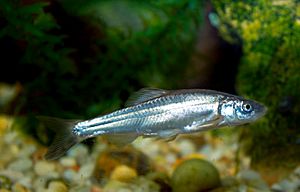Woundfin facts for kids
Quick facts for kids Woundfin |
|
|---|---|
 |
|
| Conservation status | |
| Scientific classification | |
| Genus: |
Plagopterus
|
| Species: |
argentissimus
|
The woundfin (Plagopterus argentissimus) is a special type of minnow fish. It lives only in the Virgin River in the southwestern United States. This fish is the only species in its group, called Plagopterus.
Contents
What the Woundfin Looks Like
The woundfin is a small, thin, and shiny silver fish. It has a flat head and belly, a long snout, and tough, leathery skin. It doesn't have any scales.
You can spot a woundfin by the small feelers, called barbels, at the corners of its mouth. Its name probably comes from the first sharp ray on its dorsal fin (the fin on its back). This ray is very pointy!
Woundfins usually grow to be about 7.5 centimeters (3 inches) long. You can tell them apart from other similar fish because they have these unique barbels.
Where Woundfins Live
Long ago, woundfins lived in many parts of the lower Colorado River basin. This included the Virgin River and parts of the Gila River.
However, people built dams and changed the water flow. This destroyed many of their homes. Because of this, woundfins disappeared from many of these areas.
Also, some new fish, like the red shiner (Cyprinella lutrensis), were brought into the rivers. These new fish caused the woundfin population in the Virgin River to shrink. Today, the woundfin is an endangered species. This means it is at risk of disappearing forever.
Woundfin Habitat
Woundfins can live in water that has a lot of minerals and is cloudy. They usually prefer warm, fast-moving streams that are not very clear.
They like water that flows at about one to two feet per second. They also prefer depths of eight to eighteen inches. Woundfins live in parts of streams that can be a bit salty. They tend to stay away from very clear water and are rarely found in calm, still pools.
What Woundfins Eat
The woundfin is an omnivore, which means it eats both plants and animals. What it eats depends on what is available in its habitat.
They feed on things like dead plant and animal bits, algae, seeds, and water insects. They also eat the young forms of insects, called larvae.
Protecting the Woundfin
The woundfin used to live in more places, like the lower Colorado River and the Gila River. But building dams and changing water flow destroyed their homes. Also, new fish like the red shiner were introduced. Red shiners compete for food and even eat woundfin eggs and young fish. These problems caused the woundfin to disappear from many areas and made their numbers drop in the Virgin River.
Since 1970, the woundfin has been listed as an endangered species. This means it is in danger of becoming extinct. The IUCN Red List calls it "Vulnerable," and NatureServe says it is "Critically Imperiled," which is the most serious warning. The United States Fish and Wildlife Service says the woundfin population is "declining."
The Dexter National Fish Hatchery in Dexter, New Mexico studies woundfins. They are working to help save the species. They have even successfully helped the fish reproduce in special tanks. However, attempts to move these fish to other rivers have not worked because they don't reproduce there.
In 2007, about 50 woundfins were released into the Hassayampa River in Arizona. These fish were raised at the hatchery from wild Virgin River fish. The only wild woundfin population still lives in the Virgin River.
There's a big effort to get rid of red shiners from the Virgin River in Utah. This has almost removed red shiners from areas where they used to be common. Fish barriers have been built to stop red shiners from coming back. This has allowed hatchery-raised woundfins to be put back into the river. Thousands of woundfins were released in 2007 and 2008. Now that red shiners are less of a threat, the biggest dangers to woundfins are low water levels and very hot temperatures.
Another minnow, the Virgin chub (Gila seminuda), lives in many of the same places as the woundfin. It faces similar threats, like competition from the red shiner and dirty water from farms.
- Valid species list of genus Plagopterus on FishBase.
- Froese, Rainer, and Daniel Pauly, eds. (2006). "Plagopterus argentissimus" in FishBase. May 2006 version.
See also
 In Spanish: Plagopterus argentissimus para niños
In Spanish: Plagopterus argentissimus para niños


